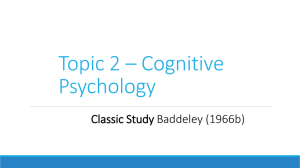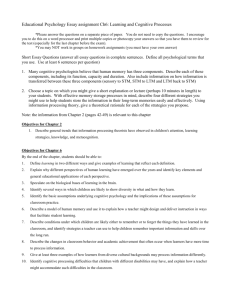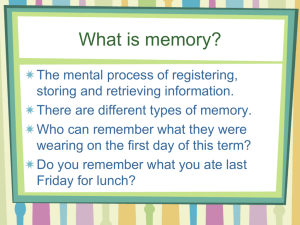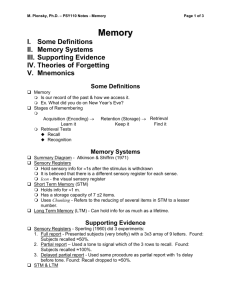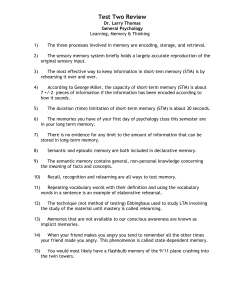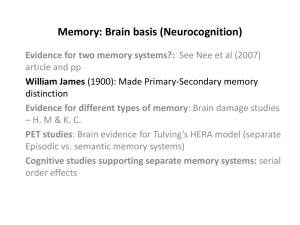Studies that support MSM
advertisement
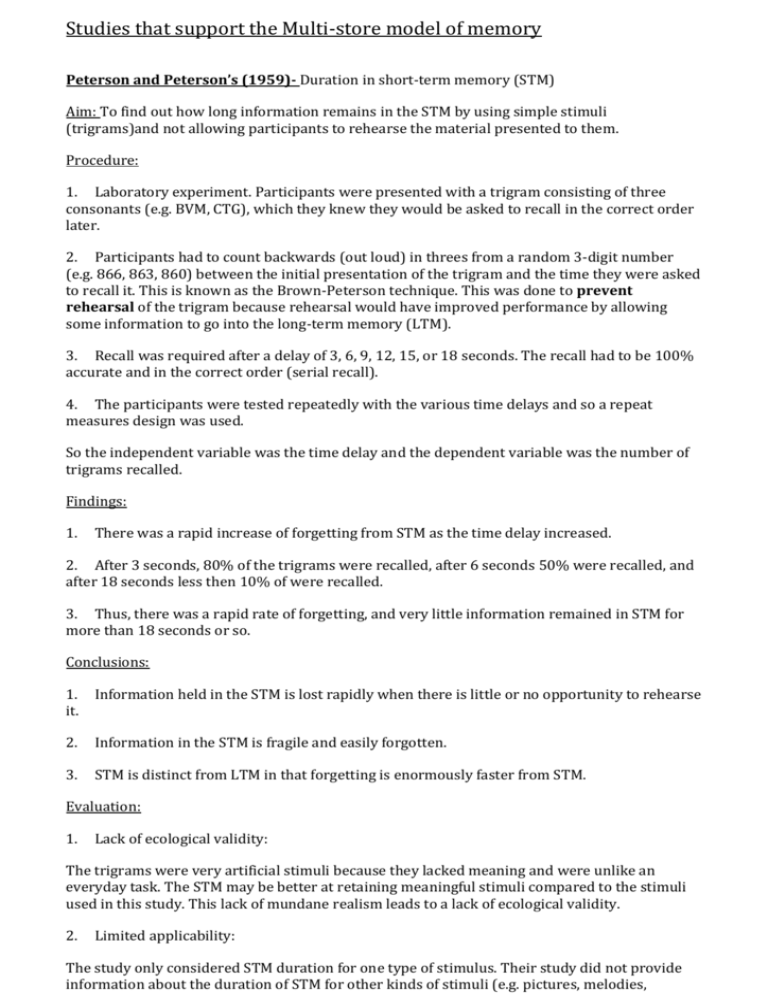
Studies that support the Multi-store model of memory Peterson and Peterson’s (1959)- Duration in short-term memory (STM) Aim: To find out how long information remains in the STM by using simple stimuli (trigrams)and not allowing participants to rehearse the material presented to them. Procedure: 1. Laboratory experiment. Participants were presented with a trigram consisting of three consonants (e.g. BVM, CTG), which they knew they would be asked to recall in the correct order later. 2. Participants had to count backwards (out loud) in threes from a random 3-digit number (e.g. 866, 863, 860) between the initial presentation of the trigram and the time they were asked to recall it. This is known as the Brown-Peterson technique. This was done to prevent rehearsal of the trigram because rehearsal would have improved performance by allowing some information to go into the long-term memory (LTM). 3. Recall was required after a delay of 3, 6, 9, 12, 15, or 18 seconds. The recall had to be 100% accurate and in the correct order (serial recall). 4. The participants were tested repeatedly with the various time delays and so a repeat measures design was used. So the independent variable was the time delay and the dependent variable was the number of trigrams recalled. Findings: 1. There was a rapid increase of forgetting from STM as the time delay increased. 2. After 3 seconds, 80% of the trigrams were recalled, after 6 seconds 50% were recalled, and after 18 seconds less then 10% of were recalled. 3. Thus, there was a rapid rate of forgetting, and very little information remained in STM for more than 18 seconds or so. Conclusions: 1. it. Information held in the STM is lost rapidly when there is little or no opportunity to rehearse 2. Information in the STM is fragile and easily forgotten. 3. STM is distinct from LTM in that forgetting is enormously faster from STM. Evaluation: 1. Lack of ecological validity: The trigrams were very artificial stimuli because they lacked meaning and were unlike an everyday task. The STM may be better at retaining meaningful stimuli compared to the stimuli used in this study. This lack of mundane realism leads to a lack of ecological validity. 2. Limited applicability: The study only considered STM duration for one type of stimulus. Their study did not provide information about the duration of STM for other kinds of stimuli (e.g. pictures, melodies, smells). 3. Proactive interference: The participants were given many trials with different trigrams and may have been confused. Keppel and Underwood (1962) used the same task as Peterson and Peterson but observed no forgetting over time on the very first trial. Hence, forgetting is caused in part by “proactive interference” which is the disruption of current learning and memory by previous learning. Only the first trigram presented is free from proactive interference. Miller (1956)-The capacity of STM The digit span technique is a simple but effective way of measuring the capacity of STM. The experimenter reads the list of digits and asks people to repeat them in the same order that they were presented. By making the lists longer, you can find the point at which STM is ‘full’ and can no longer take in any more information. Laboratory experiments have shown that most people can remember about 7 numbers. George Miller (1956) described the capacity of STM as ‘the magical number 7, plus or minus 2’. In a series of experiments, Miller found that the short-term memory store could hold, on average, between 5 and 9 items of information. Chunking Miller found that the capacity of STM stored can be increased by a process known as chunking. This refers to the grouping of items into larger units or chunks. Miller suggested that no matter how large the chunk is, it takes up only one space in STM. Simon (1947) found that STM was quite capable of holding 7 or so chunks of information when each chunk was a single word, but if the chunks were increased, then capacity drops. For example, capacity drops to 4 for two-word phrases and 3 for eight-word phrases. In the world of chunks, size does matter. Chunking is even more effective if the words have meaning. E.g. BBC-ITV-ABC-CDROM is easier to remember than BB-CA-BC-IT-VC-DR-OM, even though these are just the same letters in another order. This illustrates an important point: simply breaking a sentence up into fewer segments is not as helpful to memory as breaking the sequence up into fewer meaningful segments. Baddeley’s (1966) Encoding in Short Term Memory (STM) Aim: To investigate whether acoustic encoding (based on the sound of the word) is used primarily in STM (this does not mean that semantic encoding is not used at all). Method: Laboratory experiment. Baddeley used four types of word lists: - Acoustically similar (e.g. meet/feet/sweet) Semantically similar (e.g. neat/clean/tidy) Acoustically dissimilar (e.g. hot/far/jam) Semantically dissimilar (e.g. pen/jump/day) The independent variable was the type of word list and the dependent variable was the number of substitution errors. Participants were asked to recall the words in the same order as the order of presentation either immediately (for STM) or after a timed delay (for LTM). Findings: With immediate results there were more substitution errors on the acoustically similar lists than on the acoustically dissimilar lists. This confirms that acoustic encoding is used in STM. There was no difference in performance at immediate recall between the semantically similar and semantically dissimilar lists, suggesting that meaning is not important in STM. Conclusion: This study successfully displays the fact that STM uses acoustic encoding and not semantically similar. This supports the MSM as it shows that the encoding is on the basis of sound rather than meaning, because we rehearse what we say over and over to ourselves. Evaluation: The study lacks mundane realism, because people in real life very rarely learn word lists under controlled conditions. As a result, the experiment may lack ecological validity and thus can not be applied to everyday memory. There are more codes than simply acoustic and semantic, with other codes being preferred depending on the nature of the information being encoded. Baddeley (1966) Encoding in Long Term Memory (LTM) Aim: To investigate whether semantic encoding (based on the meaning of the word) is used in Long-Term Memory (LTM) Method: This was a laboratory experiment. Baddeley used the following word lists to investigate STM and LTM: -Acoustically similar (e.g. Meet/feet/sweet) -Semantically similar (e.g. Neat/clean/tidy) -Acoustically dissimilar (e.g. Hot/far/jam) -Semantically dissimilar (e.g. Pen/jump/day) The independent variable was the type of word list (similar/dissimilar) and the dependent variable was the number of substitution errors made (when one item is confused with another). To investigate long-term memory, the participants were asked to recall the words in the same order as the order of presentation after a timed delay. Findings: Memory performance in terms of substitution errors did not differ between the acoustically similar and acoustically dissimilar list. This suggests that acoustic encoding is not used in LTM. However, words in semantically similar lists were more confused with each other than were words in semantically dissimilar lists. These results show that encoding in LTM is based on the meaning of a word rather than on its sound. Evaluation: The results of this study show the importance of semantic encoding for LTM. They also show the differences between encoding for STM and encoding for LTM. The study was a lab experiment and therefore lacks mundane realism, which reduces the ecological validity. People are not likely to be asked to memorize word lists in real life, therefore the results may not be able to be applied to everyday memory. The experiment also does not acknowledge codes other than acoustic and semantic in encoding information such as visual, taste and smell. It does not make sense to say that all information in the LTM is encoded semantically. The type of encoding may depend on the type of stimulus given. Information in LTM can be encoded acoustically, visually, or by taste and smell. Glanzer and Cunitz 1966 -Serial Position Curve Aim: To determine if serial position (the order in which words are presented), has an effect on recall. This was tested on immediate and delayed free recall. (Free Recall: when participants attempt to recall items in any order). Method: Laboratory experiment. Researchers presented participants with a list of 15 words which the participants knew they had to memorize. Half the participants were asked to recall the words immediately (Immediate free recall condition, IFR), whilst the other half were asked to recall them after 30 seconds (Delayed Free Recall Condition, DFR). To prevent the delayed participants from rehearsing numbers, participants were asked to count backwards in threes from a three digit number (known as the Brown Peterson technique). Findings: In the IFR condition, Glanzer and Cunitz obtained the expected serial position curve consistent with MSM, with pronounced primacy and recency effects. Primacy effect: Reflects recall from the LTM, as the first few items attract attention Recency effect: Last few items rehearsed were still in the STM when participants are asked to recall. For the DFR condition, the MSM predicts that whilst a delay of 30 seconds should not effect the recall from the LTM, given the STM does not last longer than 30 seconds, the recency effect would disappear, which is what they found as the percentage of people who could recall the last few words dropped from 55% in the IFR condition to 30% in the DFR condition. Evaluation: A well controlled laboratory experiment that supports the distinction between the STM and LTM and therefore provides support for the MSM. Low ecological validity because the task given to the participants would not be relevant in everyday life. Neuropsychological evidence for the MSM HM HM underwent brain surgery in 1953 in order to correct his epilepsy. HM’s operation resulted in the removal of more of his brain than was intended, and the surgery was revealed to have profound effects on his memory. In the surgery, an important part of his hippocampus was removed. This allowed researches to make inferences about the role of the hippocampus in memory, although there are a number of factors that made it difficult to be sure about cause and effect. For example: It was unclear until 1997 the extent to which the hippocampus was damaged HM was using anti-epileptic drugs after the operation, which may have caused further damage to his brain. HM’s memory problems included: An inability to create new long-term memories. This is called ‘anterograde amnesia’ (could hold information in his working memory but when distracted, he would forget). Able to remember some of his childhood but had little memory of the 11 years prior to his surgery. This is called ‘retrograde amnesia’ (loss of memory from before an event, i.e. HM’s surgery) Odgen (2005) described the fact that HM was unable to detect the time that had passed, most likely because he was not forming any new memories. It was clear that he picked up a few facts about things after the operation as he had some idea about who Elvis Presley and John F. Kennedy were. HM’s STM was relatively normal but he could not transfer new information from his STM to his LTM after his operation. - The combination of a largely intact STM and a very damaged LTM can be taken as evidence that we have different memory systems. - The logic behind this is that if STM and LTMs are distinct memory stores, then some types of brain damage to one store should leave the other unaffected (Braddeley, 2009) Clive Wearing A British musicologist, conductor, tenor and keyboardist who suffers from chronic anterograde amnesia. Lacks the ability to form new memories and can only recall some aspects of his past memories. In 1985, Wearing contracted Herpesviral encephalitis, a Herpes simplex virus that attacked his central nervous system, and as a result developed a profound case of amnesia. The hippocampus, an area of the brain required to transfer memories from short-term to long-term memory, is damaged, meaning that he is unable to store new memories. It is reported that his memory ‘restarts’ or ‘refreshes’ approximately every 20 seconds. He knows that he has children form an earlier marriage, but cannot remember their names. His love for his second wife who he married the year prior to his illness is undiminished (he greets her joyously every time they meet, either believing he has not seen her in years or that they have never met before, even though she may have just left the room to fetch a glass of water. He remembers the name of food (e.g. chicken), however cannot link it with taste (as he has forgotten). He has also been unable to control his emotions and associated memories well.

